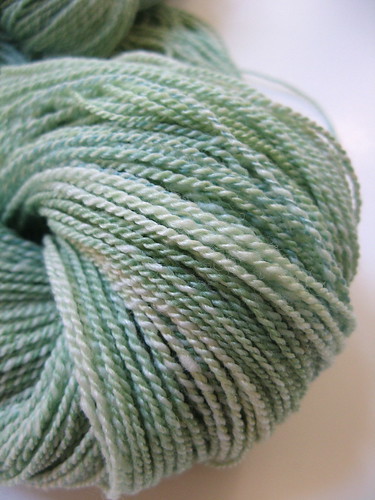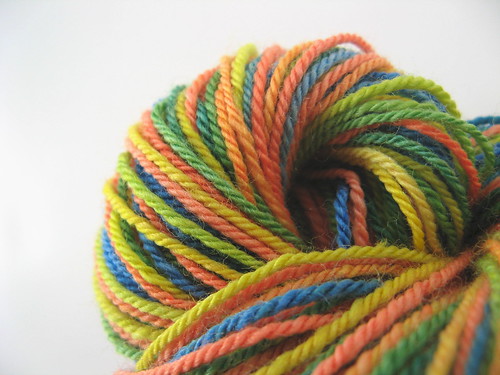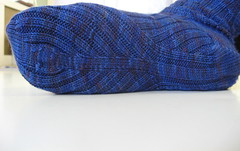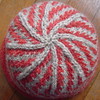handpainted
I was meaning to post earlier, but then we kinda sorta bought a house, and things got exciting. But now that we're moved in*, it seems like a good time to revisit the blog.
(* By "moved in", I mean the same thing some knitters do when they talk about a "FO" that hasn't been blocked, and still has ends hanging out. Boxes? What boxes?)
We spent a lot of time painting. Alex more-so than me. And we still have a bit left to do, in addition to some finishing I want to do on a built-in storage unit in my office closet. Things aren't all settled and in their place yet, and I don't have any photos of things as they are now, but I do have a couple of photos of my office, from when I just started to move into it. My office with beautiful, beautiful handpainted walls. (It's really too bad you can't use the crock pot method on walls...)

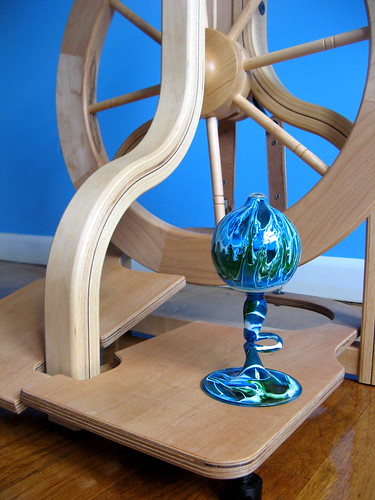
Okay, that second one was just a silly shot. But I love that oil lamp, and it goes so well with the walls. I find the blue very calming, and I'm quite pleased with the colors I chose. You can't tell all that much from the photos, but there are actually 2 different shades of blue on the walls. If you want to copy me (and I highly recommend it, because these are very, very good blues), I used Sherwin Williams paint in the colors "Honolulu Blue" and "True Blue".
I'm going to do a photo dump of other stuff I've been saving up, because it's just been waiting too long, and I need to get around to blogging about it!
First up is my first real longdraw project. I bought 4 oz. of rambouillet roving at the NH Sheep and Wool festival in May. When I say roving, I mean it. A lot of people (sometimes me, I admit) call commercially combed top "roving", but roving technically refers to a carded fiber. This stuff was roving, which made it ideal for that longdraw, woolen spinning.


This skein is 84 grams, 346 yards, and 16.5 wpi untensioned (20.5 wpi tensioned). It's a 3 ply, and I consider it about a sportweight. Notice the yardage! Now, I lost a lot of the singles because of some uneven spinning, and probably uneven splitting of the top. I had a lot of singles left on two of the bobbins, after the first one ran out. If this skein weighed 4 oz., it would have had about 450 yards, which sounds solidly like a fingering weight yarn. But thus is the magic of longdraw woolen spinning -- you tend to get more yardage for your buck, probably because the fibers aren't as densely packed in there, giving you a lighter, airier yarn, really stretching the yardage you can get from a given amount of fiber. I'd heard of this phenomenon, but I didn't quite believe it until I made it happen with my own two hands.
I have tried longdraw and other woolen techniques before, but I never had much success until working with this fiber. I think part of it is the fiber -- rambouillet is very crimpy, and seems well suited to "spinning without training wheels", which is what longdraw feels like. The prep was also important. While I've tried longdraw with drum carded merino batts, it didn't work really well, probably because merino is so fine that carding it doesn't really get it in the same jumbled up state as carding a fiber like rambuoillet. But this is only speculation. There might have also been a learning curve on my part.
My other somewhat recent finished spinning project is perhaps my favorite of my handspuns. (Though it's so hard to choose.) Practice really does help, because this yarn is chain plied (Navajo plied), and I feel that it was my best effort at that technique, to date.


The yarn is South African Fine wool, and was dyed by Adrian at Hello Yarn. It's 94 grams, 300 yards, and 20 wpi, for a fingering weight. Aren't those colors just amazing! I love Adrian's dyeing, and feel like it makes my yarns that much better. You all should try her stuff, though please don't jump in front of me in line when she opens her fiber club back up. ;-) (Really, her stuff is the only stuff I'll haunt to try to snatch up, as it sells out within minutes. Nothing else is worth it to me like her fiber is. And I promise she's not paying me to say this. It's just that pretty and unique.)
There's not much more to say about that yarn, partially because it's been so long since I've spun it, and partially because the colors temporarily shut off all parts of my brain not dedicated to "oooh.... pretty...." when I look at it. It will be socks. Possibly plain stockinette socks, so the colors can just do their thing, completely uninterrupted.
That will be it for now. There is still time to enter the contest (see previous post). I will take entries until at least the end of September 1, but if you feel like entering late, feel free. I'll probably just accept any entries that come before I get around to doing the drawing for the winner. I have some stuff (of the non-pleasant sort) going on for a lot of next week, so look for the entry announcing the winner (and probably some more knitting/spinning bloggy stuff) the weekend after this coming weekend. Maybe earlier, if next week goes better than planned.
And thank you to all of the people who have already entered. You guys have some awesome plans, and it's been a blast reading what you have to say.
(* By "moved in", I mean the same thing some knitters do when they talk about a "FO" that hasn't been blocked, and still has ends hanging out. Boxes? What boxes?)
We spent a lot of time painting. Alex more-so than me. And we still have a bit left to do, in addition to some finishing I want to do on a built-in storage unit in my office closet. Things aren't all settled and in their place yet, and I don't have any photos of things as they are now, but I do have a couple of photos of my office, from when I just started to move into it. My office with beautiful, beautiful handpainted walls. (It's really too bad you can't use the crock pot method on walls...)


Okay, that second one was just a silly shot. But I love that oil lamp, and it goes so well with the walls. I find the blue very calming, and I'm quite pleased with the colors I chose. You can't tell all that much from the photos, but there are actually 2 different shades of blue on the walls. If you want to copy me (and I highly recommend it, because these are very, very good blues), I used Sherwin Williams paint in the colors "Honolulu Blue" and "True Blue".
I'm going to do a photo dump of other stuff I've been saving up, because it's just been waiting too long, and I need to get around to blogging about it!
First up is my first real longdraw project. I bought 4 oz. of rambouillet roving at the NH Sheep and Wool festival in May. When I say roving, I mean it. A lot of people (sometimes me, I admit) call commercially combed top "roving", but roving technically refers to a carded fiber. This stuff was roving, which made it ideal for that longdraw, woolen spinning.


This skein is 84 grams, 346 yards, and 16.5 wpi untensioned (20.5 wpi tensioned). It's a 3 ply, and I consider it about a sportweight. Notice the yardage! Now, I lost a lot of the singles because of some uneven spinning, and probably uneven splitting of the top. I had a lot of singles left on two of the bobbins, after the first one ran out. If this skein weighed 4 oz., it would have had about 450 yards, which sounds solidly like a fingering weight yarn. But thus is the magic of longdraw woolen spinning -- you tend to get more yardage for your buck, probably because the fibers aren't as densely packed in there, giving you a lighter, airier yarn, really stretching the yardage you can get from a given amount of fiber. I'd heard of this phenomenon, but I didn't quite believe it until I made it happen with my own two hands.
I have tried longdraw and other woolen techniques before, but I never had much success until working with this fiber. I think part of it is the fiber -- rambouillet is very crimpy, and seems well suited to "spinning without training wheels", which is what longdraw feels like. The prep was also important. While I've tried longdraw with drum carded merino batts, it didn't work really well, probably because merino is so fine that carding it doesn't really get it in the same jumbled up state as carding a fiber like rambuoillet. But this is only speculation. There might have also been a learning curve on my part.
My other somewhat recent finished spinning project is perhaps my favorite of my handspuns. (Though it's so hard to choose.) Practice really does help, because this yarn is chain plied (Navajo plied), and I feel that it was my best effort at that technique, to date.


The yarn is South African Fine wool, and was dyed by Adrian at Hello Yarn. It's 94 grams, 300 yards, and 20 wpi, for a fingering weight. Aren't those colors just amazing! I love Adrian's dyeing, and feel like it makes my yarns that much better. You all should try her stuff, though please don't jump in front of me in line when she opens her fiber club back up. ;-) (Really, her stuff is the only stuff I'll haunt to try to snatch up, as it sells out within minutes. Nothing else is worth it to me like her fiber is. And I promise she's not paying me to say this. It's just that pretty and unique.)
There's not much more to say about that yarn, partially because it's been so long since I've spun it, and partially because the colors temporarily shut off all parts of my brain not dedicated to "oooh.... pretty...." when I look at it. It will be socks. Possibly plain stockinette socks, so the colors can just do their thing, completely uninterrupted.
That will be it for now. There is still time to enter the contest (see previous post). I will take entries until at least the end of September 1, but if you feel like entering late, feel free. I'll probably just accept any entries that come before I get around to doing the drawing for the winner. I have some stuff (of the non-pleasant sort) going on for a lot of next week, so look for the entry announcing the winner (and probably some more knitting/spinning bloggy stuff) the weekend after this coming weekend. Maybe earlier, if next week goes better than planned.
And thank you to all of the people who have already entered. You guys have some awesome plans, and it's been a blast reading what you have to say.


